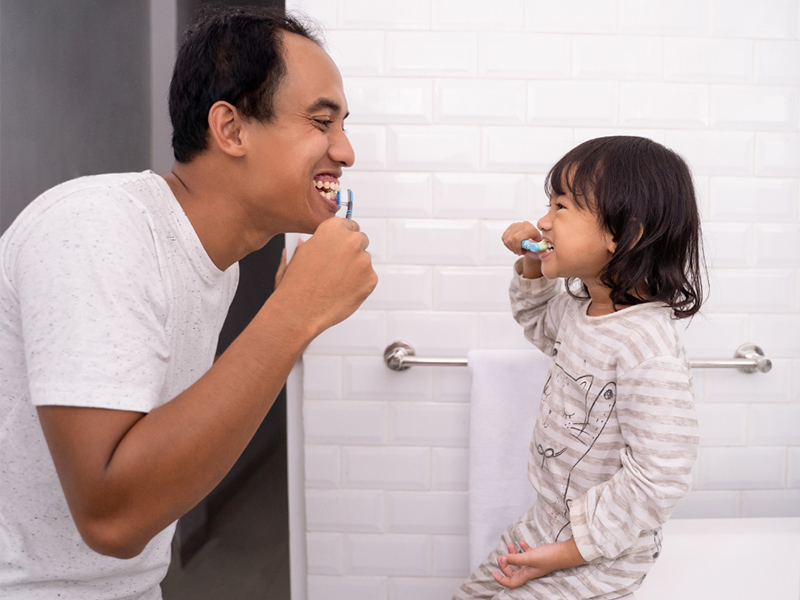We know the do’s and dont’s when it comes to our own teeth – brush twice a day, floss regularly and visit the dentist every six months. But how do you tackle kids’ dental care? Do the same rules apply? Dr Ng Wei Xuan from The Dental Studio talks to us about electric toothbrushes for kids, fluoride in toothpaste and everything else you need to know about keeping their baby teeth healthy. Read on for more!

What are the biggest myths when it comes to dental care for kids?
Many believe that baby teeth do not require much professional attention since they fall out anyway. Unfortunately, that is not true! Baby teeth act as placeholders for adult teeth in future. If they’re damaged or lost too early due to poor oral health, it can affect the development of permanent teeth.
Another common misconception is that as long as children do not consume sweets or candy, they’re not susceptible to tooth decay. That’s partially true: avoiding sweets and candy will help. But children should also avoid snacking frequently and not brushing their teeth. Remember, sugars exist in many forms, including in milk and fruits.

Is it a case of the earlier the better?
Research has shown that kids who had their first dental visit before their first birthday were less likely to require subsequent restorative or emergency visits.
While some parents may feel no need for a dental visit if there are no issues, it’s important to remember that problems such as dental decay may not be obvious to the untrained eye. The bottom line? When it comes to baby teeth, prevention is still better than cure!
At what age should kids first see a dentist? How often should they do this?
We recommend the first visit should be between when your child’s first milk tooth erupts and be no later than their first birthday. Subsequently, your child should visit the dentist twice a year, the same recommendation as for adults.
How do you teach kids to brush their teeth?
When your child can hold a toothbrush, it is time for them to learn brushing. Here are some tips to keep in mind:
- To start off, let your child watch you brush your teeth – children learn best by mimicking.
- Children can also learn by brushing their soft toy’s teeth.
- Brush for at least two minutes, twice a day.
- Using a timer or playing a tooth-brushing video can help. Alternatively, some electronic toothbrushes have a built-in timer.
- When brushing, move in a circular motion or in lines moving away from the gums.
- If using an electric toothbrush, parents can help to position the brush head correctly on the gumline.
Brushing aside, parents should also encourage kids to floss at least once a day. By age 7 or 8, your child should be able to brush and floss independently.

How do you foster good teeth brushing habits?
Parents should forge good brushing habits and prioritise dental care for kids at a young age. Let your child choose his or her own toothbrush and toothpaste – this makes tooth brushing fun and motivates them to brush their teeth frequently.
For children who are just starting out, creating a reward system can help incentivise them as well. For instance, the American Academy of Pediatric Dentistry (AAPD) has an easy-to-use calendar called the “Mouth Monster Daily Tracker”. This is available to download on their website.
Brushing teeth can also be a group activity with siblings or parents. Brushing teeth together serves as a good bonding activity and teaches them that your family takes oral health seriously.
Is there anything to look out for when choosing toothpaste for kids?
Fluoride, fluoride, fluoride! Fluoride plays three important roles in helping to prevent decay:
- It limits “demineralisation” of the tooth surface, which is the loss of minerals from the tooth surface.
- It enhances “remineralisation”, which helps our teeth be more acid-resistant.
- It inhibits the activity of bacterial enzymes.
Parents should help to identify fluoridated toothpastes that contain at least 1,000 ppm of fluoride. As for the flavour, it’s up to them to decide.
Should kids be using regular toothbrushes or electric toothbrushes?
Your child may use either a manual or an electric toothbrush. When selecting a toothbrush for your child, keep the following in mind:
- Ensure that the toothbrush is designed for smaller hands and mouth. (It should feature short, easy-to-grip handles and a smaller brush head.)
- Look for polished, soft-bristled toothbrushes.
- The toothbrush (or brush head, for electric toothbrushes) should be replaced every three months or when it starts fraying.
6836 5000 | 8182 2608
dentalstudio.sg
Written in collaboration with Dr Ng Wei Xuan from The Dental Studio Tai Thong (Potong Pasir)
If you’re looking at international schools in Singapore, here are some parents’ views!





